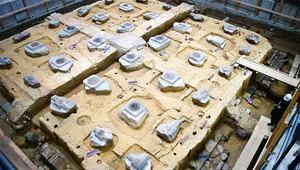Norihide Furusawa
Source - http://ajw.asahi.com/article/behind_news/social_affairs/AJ201502280009?

Yakushiji temple's Toto east pagoda before reconstruction (Asahi Shimbun file photo)
After uncovering the entire original base platform of the national treasure Toto pagoda at Yakushiji temple here, researchers praised the ancient builders for their skilled use of the rammed-earth method for a stable foundation.
The foundation of Toto (east pagoda) of Yakushiji temple showed an "exquisite" use of the ancient construction method, in which layers of sand and soil are tamped down to strengthen the foundation, researchers at the Nara National Research Institute for Cultural Properties and the prefectural Archaeological Institute of Kashihara said on Feb. 26.
Kakichi Suzuki, a former director-general of the national institute who heads a special committee to lead reconstruction work of the tower, was impressed.
“I have never seen such an exquisite example of the 'Hanchiku' (rammed-earth) method,” the architectural historian said. “It is surprisingly well-preserved.”

The foundation at Yakushiji Toto east pagoda in Nara shows accumulated layers of soil. (Norihide Furusawa)
The examination of the original base platform came as the tower is undergoing reconstruction work for the first time in 110 years.
The foundation measuring 13 meters square consisted of about 25 layers each with a depth of 2.5 to 6 centimeters. They were apparently hardened by rods 4-5 cm in diameter.
Yakushiji temple was originally built in Fujiwara-kyo, the Japanese capital between 694 and 710. It was then moved to Heijo-kyo in Nara, with the original temple called Moto-Yakushiji.
Keiji Matsumura, director-general of the Nara national research institute, said, “I believe they transferred the temple quite faithfully following the Fujiwara-kyo temple.”

A base platform with foundation stones to support pillars at Yakushiji temple in Nara (Norihide Furusawa)
The latest investigation also discovered that Toto’s base platform used granite for its “jifukuishi,” or long horizontal base stones, much like temples constructed during the Asuka Period (592-710). In comparison, many temples in Heijo-kyo used tuff rock for its easier processing qualities.
A Wado-kaichin coin, believed to have been buried as part of a groundbreaking ceremony at the Toto pagoda’s foundation, was also discovered in a foundation stone hole.
Yakushiji temple was listed as a UNESCO World Heritage site in 1998, with a number of culturally valuable Buddhist statues housed on the location.